Welcome back to Constellation Friday! Today, in honor of the late and great Tammy Plotner, we will be dealing with Canes Venatici constellation.
In the 2nd century CE, Greek-Egyptian astronomer Claudius Ptolemaeus (aka. Ptolemy) compiled a list of the then-known 48 constellations. His treatise, known as the Almagest, would be used by medieval European and Islamic scholars for over a thousand years to come. Today, this list has been expanded to include the 88 constellations recognized by the IAU.
One of these is known as Canes Venatici, a small northern constellation that is bordered by Ursa Major to the north and west, Coma Berenices to the south, and Boötes to the east. Canes Venatici belongs to the Ursa Major family of constellations, along with Boötes, Camelopardalis, Coma Berenices, Corona Borealis, Draco, Leo Minor, Lynx, Ursa Major, and Ursa Minor.
Name and Meaning:
The small northern constellation of Canes Venatici represents the hunting dogs – Chara and Asterion – of Boötes. It is also one of three constellations that represent dogs, along with Canis Major and Canis Minor. Given its comparatively recent origin, there is no real mythology associated with this asterism. However, it does have an interesting history.
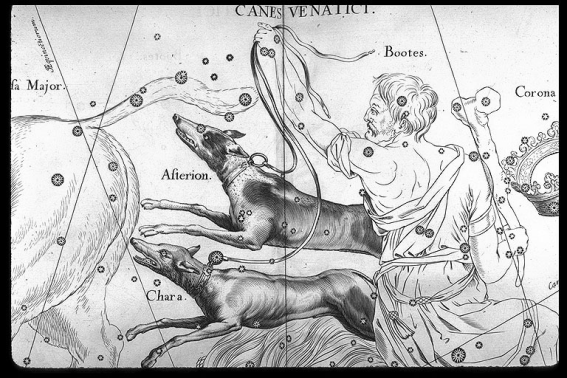
History of Observation:
During Classic Antiquity, the stars of Canes Venatici did not appear very brightly in the night sky. As such, they were listed by Ptolemy as unfigured stars below the constellation Ursa Major in the Almagest, rather than as a distinct constellation. During the Middle Ages, the identification of these stars as being the dogs of Boötes arose due to a mistranslation.
Some of the component stars in the nearby constellation of Boötes (which was known as the “herdsman”) were traditionally described as representing his cudgel. When the Almagest was translated from Greek to Arabic, the translator – the Arab astronomer Hunayn ibn Ishaq – did not know the Arabic word for cudgel.
As such, he chose the closest translation in Arabic – “al-`asa dhat al-kullab” -which literally means “the spearshaft having a hook” (possibly in reference to a shepherd’s crook). When the Arabic text was later translated into Latin, the translator mistook the Arabic word “kullab” for “kilab” – which means “dogs” – and wrote the name as hastile habens canes (“spearshaft having dogs”).
This representation of Boötes having two dogs remained popular and became official when, in 1687, Johannes Hevelius decided to designate them as a separate constellation. The northern of the two hunting dogs was named Asterion (‘little star’) while the southern dog was named Chara – from the Greek word for ‘joy’,.
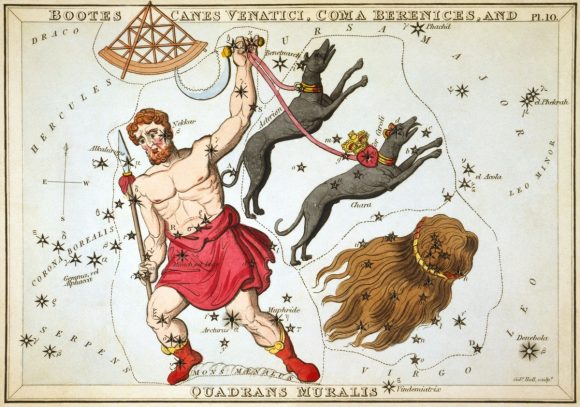
Notable Features:
The constellation’s brightest star is Cor Caroli, which is perhaps one of the most splendid of all colorful double stars. The name literally means “Charles’ heart”, and was named by Sir Charles Scarborough in honor of Charles I – who was executed in the aftermath of the English Civil War. The star is also associated with Charles II of England, who was restored to the throne after the interregnum following his father’s death.
Cor Caroli is a binary star with a combined apparent magnitude of 2.81 which marks the northern vertex of the Diamond of Virgo asterism. The two stars are 19.6 arc seconds apart and are easily resolved in small telescopes and steady binoculars. The system lies approximately 110 light years from Earth. It’s main star, a² Canum Venaticorum, is the prototype of a class of Spectral Type A0 variable stars (the so-called a² Canum Venaticorum stars).
These stars have a strong stellar magnetic field, which is believed to produce starspots of enormous extent. Due to these starspots, the brightness of a² Canum Venaticorum stars varies considerably during their rotation. Their brightness also varies between magnitude +2.84 and +2.98 with a period of 5.47 days. The companion, a¹ Canum Venaticorum (a spectral type F0 star), is considerably fainter at +5.5 magnitude.
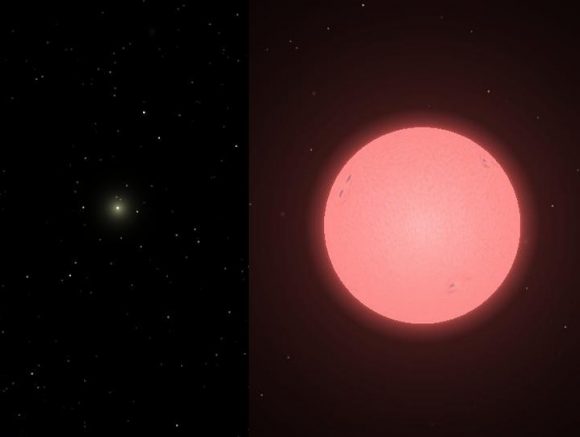
Next up is Y Canum Venaticorum (Y CVn), which was named “La Superba” by 19th century astronomer Angelo Secchi for its uncommonly beautiful red color. This name was certainly appropriate, since it is one of the reddest stars in the sky, and one the brightest of the giant red “carbon stars”.
La Superba is the brightest J-star in the sky, a very rare category of carbon stars that contain large amounts of carbon-13. Its surface temperature is believed to be about 2800 K (~2526 °C; 4580 °F), making it one of the coldest true stars known. Its appearance, temperature and composition are all indications that it is currently in the Red Giant phase of its life-cycle.
Y CVn is almost never visible to the naked eye since most of its output is outside the visible spectrum. Yet, when infrared radiation is considered, Y CVn has a luminosity 4400 times that of the Sun, and its radius is approximately 2 AU. If it were placed at the position of our sun, the star’s surface would extend beyond the orbit of Mars.
Canes Venatici is also home to several Deep Sky Objects. For starters, there’s the tremendous globular cluster known as Messier 3 (M3). Messier 3 has an apparent magnitude of 6.2, making it visible to the naked eye. It was first resolved into stars by William Herschel around 1784. This cluster is one of the largest and brightest, made up of around 500,000 stars, and is located about 33,900 light-years away from our solar system.

Then there’s the Whirlpool Galaxy, also known as Messier 51 or NGC 5194. This interacting, grand-design spiral galaxy is located at a distance of approximately 23 million light-years from Earth. It is one of the most famous spiral galaxies in the night sky, for both its grace and beauty. The galaxy and its companion (NGC 5195) are easily observed by amateur telescopes, and the two galaxies may even be seen with larger binoculars.
Canes Venatici is also home of the Sunflower Galaxy (aka. Messier 63 and NGC 5055), an unbarred spiral galaxy consisting of a central galactic disc surrounded by many short spiral arm segments. It is part of the M51 galaxy group, which also includes the Whirlpool Galaxy (M51). In the mid-1800s, Lord Rosse identified the spiral structure within the galaxy, making this one of the first galaxies in which “spiral nebulae” were identified.
Now hop over to the barred spiral galaxy known as Messier 94 for some comparison. It was discovered by Pierre Méchain in 1781 and catalogued by Charles Messier two days later. Although some references describe M94 as a barred spiral galaxy, the “bar” structure appears to be more oval-shaped. The galaxy is also notable in that it has two ring structures, an inner ring with a diameter of 70″ and an outer ring with a diameter of 600″.
These rings appear to form at resonance locations within the disk of the galaxy. The inner ring is the site of strong star formation activity and is sometimes referred to as a starburst ring. This star formation is fueled by gas that is dynamically driven into the ring by the inner oval-shaped bar-like structure.

For a completely different galaxy, try Messier 106 (NGC 4258). This spiral galaxy is about 22 to 25 million light-years away from Earth. It is also a Seyfert II galaxy, which means that due to x-rays and unusual emission lines detected, it is suspected that part of the galaxy is falling into a supermassive black hole in the center. Nearby NGC 4217 is a possible companion galaxy.
The constellation does not have any stars with known planets, and there is one meteor shower associated with the constellation – the Canes Venaticids.
Finding Canes Venatici:
While it basically consists of only two bright stars, the Canes Venatici constellation is still fairly easy to locate and is bordered by Ursa Major, Boötes and Coma Berenices. It can be spotted with the naked eye on a clear night where light conditions are favorable. However, for those using binoculars, finderscopes and small telescopes, the constellation has much to offer the amateur astronomer and stargazer.
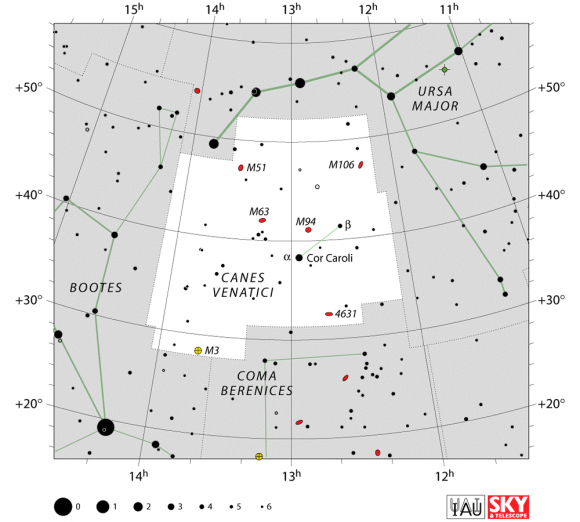
It’s brightest star, Cor Calroli can be found at RA 12h 56m 01.6674s Dec +38° 19′ 06.167″, while beautiful Y Canum Venaticorum (aka. “La Superba”) can be seen at RA 12f 45m 07s Dec +45° 26′ 24″. And M51 is easy to find by following the easternmost star of the Big Dipper, Eta Ursae Majoris, and going 3.5° southeast. Its declination is +47°, so it is circumpolar for observers located above 43°N latitude.
We have written many interesting articles about the constellation here at Universe Today. Here is What Are The Constellations?, What Is The Zodiac?, and Zodiac Signs And Their Dates.
Be sure to check out The Messier Catalog while you’re at it!
For more information, check out the IAUs list of Constellations, and the Students for the Exploration and Development of Space page on Canes Venatici and Constellation Families.
Sources:

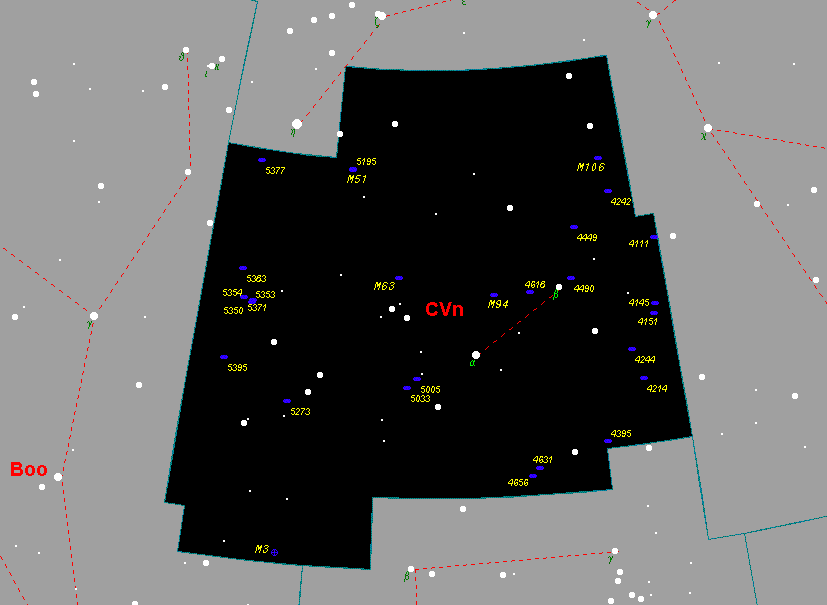
Not unlike the last copy of Tammy’s work posted here, this article is not exactly timely. This was something Tammy was always on top of.. writing about what was up in the sky that week. Part of her writing was to inspire folks to go out an take a look that night.
Don’t get me wrong I like rereading her stuff! It makes me look at my star maps and plan… to check out whatever objects she’d chatted up.
In future, would it be possible to release her blogs at the correct time of year for viewing? No biggie.. just saying.
These articles are being released in order, not to coincide with any celestial event.